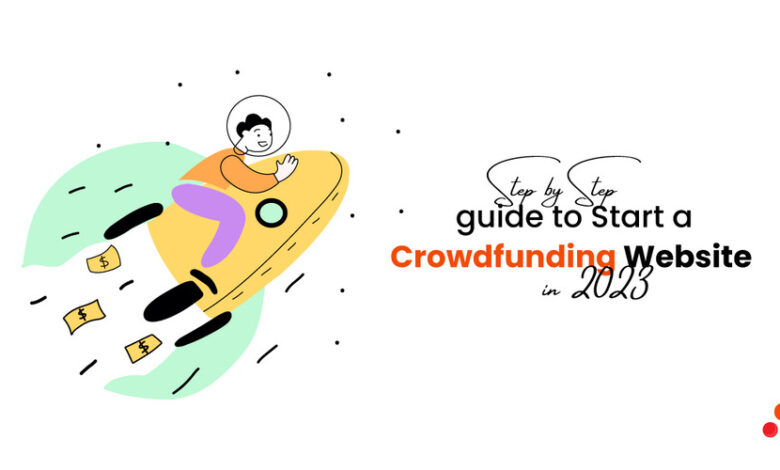
Introduction
In the world of funding dreams, crowdfunding takes center stage. But what is it exactly, and why does it matter? In this guide, we’ll unravel the magic of crowdfunding, exploring its importance and the latest trends shaping this dynamic space. As we step into 2024, the question arises: Why is now the perfect time to start your own crowdfunding website? Let’s embark on a journey to understand the power of collective support and discover why 2024 could be the year your dreams take flight.
Understanding the Landscape
Overview of the Crowdfunding Industry
- Crowdfunding involves raising small amounts of money from a large number of people to fund a project or venture.
- It’s a diverse industry with various models, including reward-based, equity-based, and donation-based crowdfunding.
- The global crowdfunding market has witnessed significant growth, providing opportunities for innovators, entrepreneurs, and creatives.
Successful Examples of Crowdfunding Platforms
- Kickstarter and Indiegogo are prime examples, known for helping launch countless products and creative projects.
- Patreon is a successful platform for creators seeking ongoing support from their audience.
- GoFundMe is widely used for personal and charitable causes, showcasing the diverse applications of crowdfunding.
Identifying Niche Opportunities
- Explore specific areas within crowdfunding, such as eco-friendly projects, social impact initiatives, or community-driven campaigns.
- Niche platforms like Crowd cube focus on equity crowdfunding, allowing investors to support startups and share in their success.
- Understanding niche markets helps tailor your platform to unique needs and interests, fostering a more engaged and supportive community.
Market Research and Planning
Conducting Market Research
Understand the Landscape:
- Investigate the current state of the crowdfunding industry.
- Analyse successful crowdfunding platforms for insights.
Identify Trends:
- Look for emerging trends in crowdfunding to stay ahead of the curve.
- Consider market demands and gaps for potential opportunities.
Competitor Analysis:
- Examine competitors in the crowdfunding space.
- Identify strengths, weaknesses, opportunities, and threats (SWOT analysis).
Defining Your Target Audience
Demographics:
- Define the age, location, and interests of your potential users.
- Consider the types of projects that resonate with your audience.
User Personas:
- Create detailed user personas for better understanding.
- Tailor your platform to meet the specific needs and preferences of your audience.
Feedback from Acquaint SoftTech:
- Leverage insights from Acquaint SoftTech to understand user behaviors.
- Align your platform features with the preferences of your target audience.
Setting Clear Objectives and Goals
SMART Goals:
- Make your goals Specific, Measurable, Achievable, Relevant, and Time-bound.
- Examples: Reach 10,000 registered users within six months; fund 50 projects in the first year.
Align with Acquaint SoftTech Expertise:
- Incorporate advice from Acquaint SoftTech for setting realistic objectives.
- Ensure your goals are aligned with the capabilities of your team.
Long-Term Vision:
- Define the long-term vision for your crowdfunding platform.
- Consider scalability and potential diversification based on market evolution.
Legal and Regulatory Considerations for Launching Your Crowdfunding Website
Launching a crowdfunding website is an exciting venture, but navigating the legal landscape is crucial for a successful start. Let’s break down the key legal and regulatory considerations in simple terms.
Legal Structure and Business Registration
- Choose Your Business Structure: Decide if you want to operate as a sole proprietorship, partnership, LLC, or corporation. This choice affects how you pay taxes and your personal liability.
- Register Your Business: Complete the necessary paperwork to officially register your business. This step ensures legal recognition and compliance with local regulations.
- Consider Local Laws: Different regions have varying rules. Be aware of and adhere to the specific regulations in your area to avoid legal complications.
Compliance with Financial Regulations
- Understand Financial Regulations: Familiarise yourself with financial regulations governing crowdfunding platforms. This may include rules related to transactions, investments, and fund transfers.
- Secure Necessary Licenses: Check if your business requires specific licenses to operate legally. Compliance ensures a smooth financial operation and builds trust with users.
- Transparent Financial Practices: Adopt transparent financial practices, providing clear information to users about fees, charges, and financial transactions. This builds credibility and trust.
Protecting Intellectual Property
- Identify Your Intellectual Property: Determine what aspects of your crowdfunding platform are unique and valuable. This may include your brand name, logo, or any proprietary technology.
- Use Contracts: When hire remote developers or any third-party service, use contracts that clearly define intellectual property ownership. This helps avoid disputes and protects your unique ideas.
- Consider Trademarks and Patents: Explore the possibility of trademarks or patents for your brand and unique features. This legal protection can prevent others from copying your innovations.
Technology and Platform Development
Choosing the Right Technology Stack
- Understand Your Needs:
- Identify the core features your crowdfunding website requires.
- Determine if you need a simple or complex technology solution.
- Consider Scalability:
- Choose technologies that can grow with your platform.
- Ensure the technology stack can handle increased user traffic.
- Explore Options:
- Research popular web development frameworks and languages.
- Consider open-source solutions for cost-effectiveness.
- Hire Remote Developers:
- Leverage the benefits of hire remote developers for a diverse and skilled team.
- Consider platforms like Acquaint SoftTech for finding remote talent.
User Interface (UI) and User Experience (UX) Design
- Prioritise User-Friendly Design:
- Create a clean and intuitive interface for easy navigation.
- Ensure a visually appealing design to engage users.
- Mobile Responsiveness:
- Opt for a responsive design to provide a seamless experience across devices.
- Prioritise mobile-friendly features for users on the go.
- Accessibility Matters:
- Implement accessibility features for users with diverse needs.
- Test the website with different devices and assistive technologies.
- Feedback Loops:
- Gather feedback from potential users during the design phase.
- Iterate based on user input to enhance the overall experience.
Mobile Responsiveness and Accessibility
- Mobile-First Approach:
- Design with mobile users in mind from the start.
- Ensure all features are accessible and functional on smaller screens.
- Test Across Devices:
- Verify the website’s performance on various devices and browsers.
- Address any issues related to responsiveness promptly.
- Collaborate with Developers:
- Foster communication between UI/UX designers and developers.
- Ensure that design elements are effectively translated into a functional website.
- Acquaint SoftTech for Hiring Developers:
- Consider Acquaint SoftTech for hiring skilled developers.
- Utilize their expertise to enhance your platform’s technical aspects.
Building a Strong Team
Roles and Responsibilities
- Define Clear Roles: Clearly outline what each team member is responsible for.
- Identify Key Positions: Pinpoint roles like project manager, developers, designers, and marketing specialists.
- Highlight Core Competencies: Ensure each team member understands their specific strengths and contributions.
Hiring Developers, Designers, and Marketing Experts
- Hire Remote Developers
- Explore Remote Talent: Leverage platforms like Acquaint SoftTech to find skilled developers.
- Global Talent Pool: Tap into a diverse pool of talent regardless of geographical boundaries.
- Cost-Efficient: Remote hiring often proves cost-effective compared to on-site options.
- Diverse Skill Sets for Designers
- Visual Appeal: Seek designers who can enhance the platform’s visual appeal.
- User Experience (UX): Prioritise those who understand and prioritise user-friendly experiences.
- Adaptability: Ensure the ability to adapt designs to different devices and user preferences.
- Marketing Experts to Drive Visibility
- Digital Marketing Savvy: Look for individuals well-versed in online marketing strategies.
- Social Media Proficiency: Find experts who understand the power of social media in promotion.
- Content Creation Skills: Identify individuals capable of creating compelling content to attract users.
Creating a Collaborative Work Environment
- Effective Communication
- Utilize Collaboration Tools: Platforms like Slack or Microsoft Teams foster real-time communication.
- Regular Check-ins: Conduct regular team meetings to share updates and address concerns.
- Open Communication Channels: Encourage team members to voice opinions and share ideas freely.
- Promote Team Bonding
- Virtual Team Building: Organize virtual team-building activities to foster camaraderie.
- Acknowledge Achievements: Celebrate milestones and achievements to boost morale.
- Create a Positive Culture: Nurture a work environment that promotes positivity and mutual support.
- Flexibility and Inclusivity
- Flexible Work Hours: Allow flexibility to accommodate different time zones.
- Inclusive Policies: Ensure policies that consider diverse backgrounds and work styles.
- Recognition of Individual Contributions: Acknowledge and appreciate individual efforts within the team.
Funding and Financial Planning
Estimating Initial Costs
Identify Essential Expenses
- Break down costs for technology, development, marketing, and legal aspects.
- Consider licensing fees, domain registration, and initial staff salaries.
Contingency Planning
- Allocate a buffer for unexpected expenses.
- Anticipate potential delays and additional costs.
Use Online Tools
- Leverage budgeting tools to estimate costs accurately.
- Explore platforms like Acquaint SoftTech for cost estimation assistance.
Funding Options (Investors, Loans, Grants)
Seeking Investors
- Create a compelling business pitch.
- Attend networking events or use online platforms to connect with potential investors.
- Highlight the benefits of your crowdfunding platform.
Exploring Loans
- Research financial institutions offering startup loans.
- Compare interest rates and terms.
- Understand the risks and responsibilities associated with loans.
Applying for Grants
- Identify relevant grant opportunities.
- Tailor your application to showcase the social impact of your crowdfunding platform.
- Consider partnerships or collaborations to strengthen your grant application.
Developing a Sustainable Revenue Model
Subscription Models
- Offer premium subscription plans for project creators.
- Provide additional features or visibility for subscribers.
Transaction Fees
- Implement a small percentage-based fee on successfully funded projects.
- Clearly communicate fee structures to users.
Collaborations and Partnerships
- Explore partnerships with businesses or organisations.
- Consider sponsored content or exclusive collaborations to generate revenue.
Hire Remote Developers
- Utilize remote development teams to minimize costs.
- Platforms like Acquaint SoftTech can connect you with skilled remote developers.
Scaling Responsibly
- Plan for scalability without compromising financial stability.
- Gradually introduce new revenue streams as your platform grows.
Platform Features and Functionalities
User Registration and Profile Creation
Simple Sign-up Process:
- Intuitive and easy registration steps.
- Minimal required information for a quick start.
Social Media Integration:
- Option to register using existing social media accounts.
- Enhances user convenience and encourages participation.
Customisable User Profiles:
- Users can personalize their profiles with bios, images, and project history.
- Provides a sense of identity within the community.
Project Creation and Management
Clear Project Guidelines:
- Simple guidelines for creating compelling projects.
- Helps users understand expectations and requirements.
Project Preview Feature:
- Allows creators to preview their project before publishing.
- Reduces errors and ensures a polished presentation.
Progress Tracking:
- Visual indicators to show the progress of each project.
- Encourages backers by showcasing achievements.
Communication Tools:
- Integrated messaging system for creators and backers.
- Facilitates easy collaboration and updates.
Payment Processing and Security
Secure Payment Gateways:
- Integration with reputable payment processors.
- Ensures safe and reliable transactions.
Multiple Payment Options:
- Support for various payment methods (credit cards, PayPal, etc.).
- Enhances accessibility for backers.
SSL Encryption:
- End-to-end encryption for data security.
- Safeguards sensitive information during transactions.
Fraud Prevention Measures:
- Implement anti-fraud tools and monitoring.
- Protects both creators and backers from fraudulent activities.
Refund and Dispute Resolution:
- Clearly defined refund policies.
- System for handling disputes professionally and transparently.
Marketing and Promotion
Pre-launch Marketing Strategies
Build Anticipation:
- Create a teaser or countdown on your website to generate curiosity.
- Release sneak peeks of your crowdfunding platform through engaging visuals and short videos.
Create a Landing Page:
- Develop a captivating landing page that highlights the unique selling points of your crowdfunding platform.
- Include a sign-up form to collect emails from interested users.
Email Marketing:
- Start an email campaign to keep potential users informed about your launch.
- Offer exclusive previews or early access to those who sign up early.
Utilize Influencers:
- Collaborate with influencers or industry experts to promote your upcoming platform.
- Leverage their reach and credibility to build trust among potential users.
Social Media Campaigns
Choose Platforms Wisely:
- Identify the social media platforms where your target audience is most active.
- Tailor your content to each platform’s format and audience preferences.
Create Engaging Content:
- Develop visually appealing content, including images, videos, and infographics.
- Craft compelling captions and use relevant hashtags to increase discoverability.
Run Contests and Giveaways:
- Encourage user participation by organising contests related to your crowdfunding theme.
- Offer exclusive rewards or early access as incentives for participation.
Engage with Your Audience:
- Respond promptly to comments, messages, and mentions.
- Foster a sense of community by actively participating in conversations related to crowdfunding.
Collaborations and Partnerships
Identify Potential Partners:
- Look for organisations, businesses, or influencers that align with your crowdfunding platform’s mission.
- Consider partners with complementary services or a shared target audience.
Joint Marketing Initiatives:
- Collaborate on co-branded marketing materials, such as blog posts, social media content, or webinars.
- Leverage each other’s networks to expand your reach.
Cross-Promotions:
- Offer mutual promotions, where your partner promotes your platform, and vice versa.
- Ensure that the collaboration is mutually beneficial and adds value to both parties.
Attend Industry Events:
- Participate in conferences, webinars, or networking events related to crowdfunding.
- Network with potential collaborators and showcase your platform to a broader audience.
Launching Your Crowdfunding Website
Beta Testing and User Feedback
Purpose of Beta Testing
- Beta testing allows you to identify and fix potential issues before the official launch.
- It involves a limited release to a select group of users to gather feedback.
Selecting Beta Testers
- Choose a diverse group to represent your target audience.
- Consider users with different devices, browsers, and levels of technical expertise.
Testing Parameters
- Test core functionalities, payment processes, and user interface.
- Encourage testers to report bugs, suggest improvements, and share their overall experience.
Feedback Gathering Tools
- Utilize surveys, feedback forms, or dedicated forums for efficient data collection.
- Actively engage with beta testers to understand their needs and concerns.
Official Launch and Promotion
Creating Buzz
- Develop a launch plan with teasers, countdowns, and sneak peeks to generate excitement.
- Leverage social media, email campaigns, and partnerships for maximum visibility.
User Onboarding
- Provide clear instructions for project creators and backers.
- Ensure a seamless sign-up process and guide users through the platform.
Launch Event
- Consider hosting a virtual launch event to showcase your platform.
- Collaborate with influencers or industry leaders to increase credibility.
Promotional Offers
- Offer early bird incentives or exclusive perks to encourage initial participation.
- Use limited-time promotions to drive urgency and engagement.
Monitoring and Iterating
Real-time Monitoring
- Implement analytics tools to track user behavior, traffic, and campaign performance.
- Monitor server performance to ensure stability during peak times.
User Support
- Set up a responsive customer support system to address user inquiries promptly.
- Use feedback loops to continuously improve user experience.
Iterative Updates
- Regularly release updates based on user feedback and evolving industry trends.
- Communicate updates transparently to build trust with your user base.
Adaptability
- Stay agile and be ready to adapt your strategies based on user data.
- Monitor market changes and be prepared to make necessary adjustments.
Maintaining and Scaling
Customer Support and Feedback Loops
- Responsive Communication:
- Ensure prompt and friendly responses to user inquiries.
- Utilize various channels like email, chat, and social media for accessibility.
- Feedback Collection:
- Encourage users to share their experiences and suggestions.
- Implement surveys and ratings to gather valuable insights.
- Implementing Changes:
- Regularly analyse feedback to identify common issues.
- Prioritise and implement changes based on user suggestions.
Continuous Improvement and Updates
- Regular Software Updates:
- Schedule routine updates to enhance platform performance.
- Fix bugs, add features, and optimize user interface and experience.
- User-Focused Enhancements:
- Prioritise improvements based on user needs and preferences.
- Stay informed about industry trends for relevant updates.
- Testing and Quality Assurance:
- Conduct thorough testing before implementing updates.
- Ensure new features do not disrupt the user experience.
Scaling Strategies for Growth
- Server Capacity Planning:
- Monitor website traffic and scale server capacity accordingly.
- Partner with reliable hosting services to accommodate growth.
- Marketing and Outreach:
- Develop targeted marketing campaigns to attract a larger audience.
- Leverage social media and partnerships for increased visibility.
- Diversify Funding Streams:
- Explore additional revenue streams beyond the core crowdfunding model.
- Consider partnerships, premium features, or affiliate programs.
- Global Expansion:
- Assess the potential of expanding into new geographical markets.
- Adapt the platform to cater to diverse cultural and linguistic needs.
- Collaborations and Partnerships:
- Seek collaborations with influencers, businesses, or organisations.
- Forge partnerships that align with the platform’s mission and values.
Conclusion
As we wrap up this journey, let’s take a moment to celebrate your achievements in launching a crowdfunding website. Your dedication and hard work have laid the foundation for a platform that fosters dreams and sparks change. Looking towards the future, the world of crowdfunding holds limitless possibilities. Embrace innovation, stay adaptable, and continue to amplify social impact. Your platform isn’t just a website; it’s a catalyst for positive change. As you move forward, remember that each project funded is a step towards a brighter, more collaborative future. Cheers to your success, and may your crowdfunding journey be ever impactful and inspiring!




